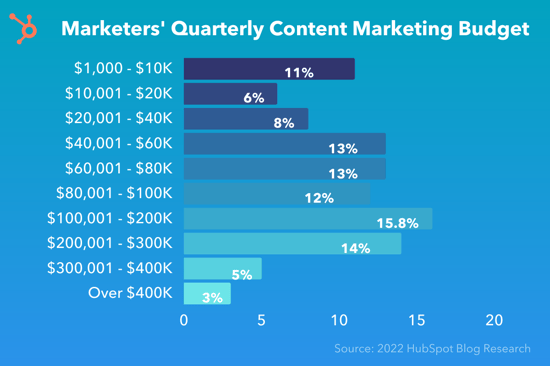If only content marketing budget dollars had more zeros and commas! However, most companies, even enterprises, may not have the budget you’d love to spend. The good news is that you don’t need to spend thousands of dollars to drive results from content. Think more grassroots style versus bloated budgets. In this post, we’ll teach you how to promote content on a shoestring budget.
What’s a “typical” content marketing budget?
There’s no standard on spending in marketing. It depends on many factors — your industry, audiences, goals, and channels. Developing a content marketing budget is a recommendation for any company, but where do most spend the bulk of their money? Here are some revelations from the Content Marketing Institute (CMI) 2021 B2B Content Marketing report:
- 43% of organizations increased budgets from 2020 to 2021, and 46 percent expect a slight increase in 2022.
- Most companies spend 10 to 24 percent of their marketing budget on content.
More data provides context on numbers. HubSpot research revealed that 26 percent of marketers spend $40,000 to $80,000 quarterly on content marketing. Those numbers represent the entire budget, from technology to outsourcing to promotion.

Image Source: Hubspot
What channels do content marketers allocate budget dollars?
When it comes to the promotional aspect of content marketing, there are several avenues that budget dollars may pay for, including:
- Social media advertising
- Paid search
- Sponsorships
- Banner ads on trade websites
- Partner emails
- Native advertising and sponsored content
- Content amplification tools (e.g., Converge, Zemanta, Outbrain, Quuu Promote)
Content marketers may use a mix of these, with 81% of organizations using paid methods to promote content. The most popular are social media ads, paid search, and sponsorships.
While using paid promotion can drive results, small budgets put many of these things out of reach. Social media ads are often a lower-cost point than paid search bidding, especially for highly competitive keywords. Sponsorships, sponsored content, and digital banners on industry websites usually start at $5,000 or more.
If these options aren’t readily available because of a lack of funds or you can only do it a few times a year, you’ll need to be scrappy about how to promote content. Much of the time, the success of promoting content relies heavily on the fundamentals.
Getting Content Marketing Fundamentals Right
High-quality content is essential to promoting it without breaking the bank. Here are some areas your enterprise content team can focus on to ensure this.
- Use a content calendar to map out every project that addresses your audience’s needs, timely topics, and your expertise.
- Get constant feedback from sales and subject matter experts (SMEs) on what matters to customers so your content angles are always fresh.
- Review content analytics often to determine which topics and formats get the most engagement.
- Define content workflows so you are constantly producing a steady stream of content, so there’s no shortage to promote across your different products and buyers.
- Develop a distribution plan for content as part of your content strategy. It can include no-cost (organic social media, SEO, emails) and paid channels.
You’ll want to have these things in place to promote content at scale. So, what are the free or low-cost options, and where should you put your dollars with paid channels?
Strategies for Promoting Content That Doesn’t Require Dollars

You have the potential to promote content in many ways without having to hit your budget. It starts with your website as the central owned asset for content distribution. It’s your blog, resource library, videos, and all other assets. From there, you have other channels to use that don’t require monetary investments.
Website Featured Content Banners and Pop-Ups
Your website is your hub. However, that doesn’t mean all visitors will visit your resources. A great way to hook them from the home page is to have a section for featured content and change that monthly. It could be a demand gen long-form content piece that’s gated to collect contact information.
You can also try pop-ups on product pages with the latest content relating to it that audiences may find helpful.
Social Media
The first rule is to be active on the profiles. You’ll see little engagement without consistently posting content. What you post should also align with that profile. What you post on Instagram will be much different than what you do on LinkedIn.
In promoting on social media, the key metric to consider is clicks on the posts. In other words, how many people went to the website and read the content or watched the video.
You can get more attention for your content when others share it. An effective way to expand this is by encouraging employees to do this.
Other best practices include using relevant hashtags and tagging other brands or individuals related to the content. For example, if the post is a case study, mention the customer.
One more tip is to join Facebook or LinkedIn groups where your customers are. Look to respond to questions they have with content that’s educational. You don’t want to be salesy but rather demonstrate thought leadership.

Email Marketing
Never underestimate the power of email marketing! It’s another owned platform that you control. You need content to fuel all kinds of email marketing:
- Newsletters
- Nurture campaigns
- Promotions
With the right recipients and subjects, you can see high engagement for your posts that can turn into conversions.
SEO
SEO isn’t a channel, but it’s critical in promotion to rank well organically. Those searchers that find you this way are often high-quality leads. They had a question, and you had the best answer. When Google rewards your content, it’s one of the best “promotions” you can obtain.
Other No-Cost Promotion Tactics
Beyond the media you control, there are other promotion strategies to consider that involve networking with the industry.
- Commit to outreach for backlinking opportunities by finding websites that might want to link to your content because it has original research or perspectives.
- Collaborate with partners for guest posting swaps and co-branded content that you can both share.
- Pitch ideas to journalists in your field to provide expert commentary through a guest post.
Since your budget isn’t zero, what channels can you get the best bang for your buck?
Using Promotion Dollars Wisely
Where you spend your money will depend on your goals and how much you have. In looking at past promotions, determine which had the best return. If your promotion budget is small, consider these wise spending tips:
- Experiment with different ads on social media profiles at smaller sums. Once you find what works best, then move dollars there.
- Run paid search campaigns with lower competition and be as niche as possible.
- Leverage low-cost amplification tools like Quuu Promote to gain more social media shares.
- Spend on sponsored content with a publication that targets your audience, has a high membership, and is the most respected.
Content Promotion Doesn’t Have to Be Dollar-Driven
The most crucial aspect to remember is that content promotion should be data-driven rather than dollar-driven. Keep analyzing all your channels and optimizing them for the best returns. Even as your budget increases, maintain a grassroots approach that allows you to be agile.
If you love this article, it’s time to subscribe to the Divvy blog, written by and for content marketers!